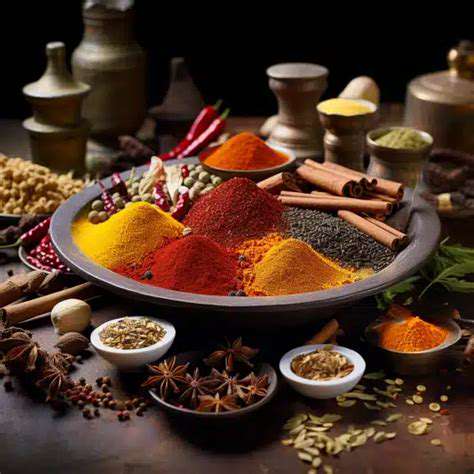Homemade Spice Blends: Customizing Flavors

Spice Blending for Flavorful Dishes
Mastering spice combinations can dramatically enhance your culinary creations, unlocking layers of taste that go beyond basic seasoning. When you take control of the heat, fragrance, and depth in your dishes, you're not just cooking—you're composing flavors. The right spice mix can turn ordinary ingredients into something extraordinary, revealing hidden dimensions in every bite. This approach invites you to journey through global cuisines while developing your own distinctive flavor signatures.
Tinkering with various spice combinations becomes an adventure for the senses. You might craft bespoke mixtures for hearty casseroles or fragrant biryanis, each blend telling its own story. Along the way, you'll uncover surprising flavor marriages and expand your kitchen repertoire beyond conventional boundaries. It's an exploration of how spices from different cultures can transform your cooking.
Understanding the Fundamentals of Spice Blends
Successful blending begins with knowing your spices intimately. Each variety brings its own personality to the mix—some whisper warmth while others shout with intensity. Recognizing how these personalities interact creates symphonies rather than cacophonies in your spice cabinet. Earthy turmeric behaves differently than fiery cayenne, and comprehending these relationships separates good blends from great ones.
Proportions make all the difference when combining spices. What works for a vibrant tikka masala would overwhelm a delicate poached fish. Precision in measurement ensures each component contributes without dominating, creating layered complexity rather than confusion. It's this careful calibration that allows spices to enhance rather than mask a dish's natural flavors.
Techniques for Creating Unique Blends
Developing signature blends involves both science and artistry. Many chefs begin with classic combinations, then tweak elements to suit their palate. This gradual refinement process might involve amplifying certain notes while muting others, much like tuning a musical instrument. The joy comes in discovering unexpected harmonies between spices that conventionally don't share the same culinary stage.
Tips for Storing and Using Your Blends
Preserving your custom creations requires thoughtful storage. Glass jars with tight seals, kept away from light and heat, maintain vibrancy far longer than plastic containers near the stove. For maximum impact, grinding whole spices just before use releases volatile oils that pre-ground versions lose over time. This extra step makes a noticeable difference in your finished dishes.
Application methods can vary as much as the blends themselves. Some mixtures shine when rubbed into meats before cooking, while others work best stirred into sauces at the last moment. Learning when and how to deploy your blends completes the circle from creation to culinary success.

Crafting Flavor Profiles: Finding Your Signature Blend
Understanding the Fundamentals of Flavor
Exceptional flavor construction begins with the five basic taste elements and their interplay. Rather than simply mixing spices, consider how sweetness might balance acidity, or how umami can anchor volatile top notes. Thoughtful combinations consider these interactions, creating blends where each component enhances the others rather than competing for attention.
The Power of Contrast and Harmony
Memorable flavors often come from calculated tension between opposites—think of how black pepper cuts through rich cream sauces. Alternatively, unified blends where all elements work in concert create comforting, familiar tastes. The artistry lies in knowing when to create spark through contrast and when to soothe with harmony, adjusting based on the dish and occasion.
Selecting Your Star Ingredients: A Guided Approach
Building your signature mix starts with understanding individual spice characteristics—their origin stories, flavor trajectories, and chemical behaviors when heated. Mix common pantry staples with one or two exotic varieties to create something uniquely yours. The discovery process involves constant tasting and adjustment until the balance feels intuitively right.
Exploring the World of Heat and Spice
Heat management separates timid blends from bold statements. Beyond Scoville ratings, consider how different peppers deliver heat—some build slowly while others attack immediately. Layering multiple heat sources creates dimensional spiciness that evolves throughout the eating experience rather than flattening the palate.
Balancing Sweetness, Sourness, and Saltiness
Great blends often incorporate balancing agents to round out sharp edges. A pinch of sugar can soften aggressive spices, while citrus zest might brighten earthy tones. Salt deserves special attention—it doesn't just make things salty, but amplifies other flavors when used judiciously. These supporting players often make the difference between good and exceptional blends.
The Art of Blending and Experimentation
Approach spice blending like a jazz musician approaches improvisation—know the rules well enough to break them creatively. Document your experiments, noting what worked and what didn't. Some of the most revolutionary flavor combinations came from happy accidents followed by methodical refinement. The path to mastery involves equal parts knowledge and intuition.
From Concept to Creation: The Blending Process
Physical preparation affects final results—coarse grinding releases flavors differently than fine powder. Consider whether your blend will benefit from toasted spices or fresh ingredients. Storage conditions impact longevity, with some mixtures improving after brief aging while others fade quickly. These practical considerations complete the transformation from idea to indispensable kitchen staple.
Establishing a Single Version of Truth (SVOT) through Master Data Management (MDM) requires creating a centralized data repository. This hub becomes the authoritative source for essential business information across all departments. Breaking down information silos leads to unified business intelligence that drives meaningful organizational progress. When all teams reference the same accurate data, decisions become more strategic and execution more precise.
- Decadent Chocolate Chip Cookies: The Secret to Perfect Chewyness
- Speedy Weeknight Dinners: 15 Minute Chicken Stir Fry
- Baking Tips and Tricks: Achieve Perfection
- Exploring Spanish Tapas Desserts: Churros and Flan
- Crispy Air Fryer Chicken Wings: Game Day Perfection
- Cooking for Special Diets: Allergies and Intolerances
- How to Store Sweet Peppers: Keep Them Fresh
- Whole30 Meal Planning: Simple and Compliant Recipes
- Kitchen Island Lighting: Style and Function
- Storing Garlic in a Cool, Dry Place: Best Practices
- How to Store Onions and Garlic: Proper Ventilation
- Storing Herbs and Spices: Maximize Potency